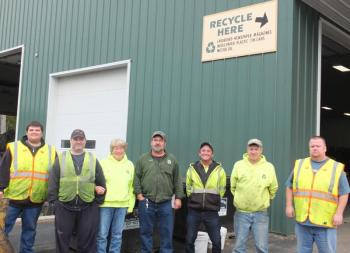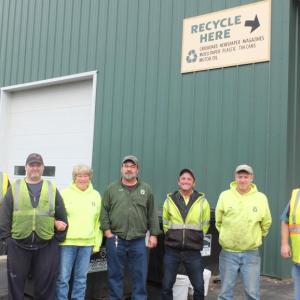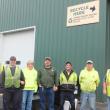If you’re not recycling then you’re just throwing it all away ...
In two years, the recycling market has gone from boom to bust. And nobody knows this better than Boothbay Region Refuse Disposal District Manager Steve Lewis. He has seen a dramatic drop in revenues from recyclables in recent months. Recyclables sales were booming as the People’s Republic of China was a major buyer in the market. But 18 months ago, China dropped out of the market, according to Lewis, resulting in a dramatic drop in sales and revenues.
Used American cardboard, newsprint, plastics and scrap metal once commanded a good price resulting in strong revenues typically over $70,000 per year for the refuse district. Lewis also recalls one year revenues were over $100,000. But not anymore. Lewis reports 2019 will likely be around $10,000.
Recycling income for cardboard is a prime example of the revenue drop. In 2017, the district sold 293.95 tons for $43,011. Last year, the district sold more tonnage, 311.1, but received less than half in revenue, $20,930. The price for cardboard is currently $18 per ton, but in recent years the price has been significantly higher and lower. “I’ve seen it as high as $300 per ton and as low as nothing. It’s crazy. I don’t understand what’s going on,” Lewis said.
The dramatic drop in recycled cardboard is also reflected in other recycled products. In the past year, district revenue for newsprint, mixed paper and scrap metal went down. Newsprint went from $6,134 for 74.93 tons in 2017 to $2,776 for 67.64 tons in 2018. Mixed paper had a more drastic reduction. It went from $9,305 for 128.8 tons in 2017 to the district paying for its removal last year. The market was so bad, it was non-existent. In 2018, it cost BRRDD $3,627 for mixed paper disposal costs. Scrap metal revenue dropped from $43,556 for 441.36 tons in 2017 to $34,628 for 266.27 tons last year.
Revenue losses were slightly offset by modest increases for other recyclables. Plastics rose from $3,767 for 10.25 tons in 2017 to $4,847 for 16.07 tons. Steel and tin cans was the only category whose revenue rose while tonnage sales declined. In 2018, the district sold 14.86 tons for $2,005 compared to $1,328 for 16.33 tons in 2017.
Despite a loss in revenue, recycling still makes economic sense. If the district simply sent all refuse to a landfill, the district would pay more in tipping fees. “Recycling revenues are not what they were. It’s never been this low before, but it’s still making money, and that’s still better than paying $150 per ton to truck it away,” Lewis said.
The BRRDD has 12 employees. Three work in the recycling center six days per week. Despite a drop in revenue, Lewis believes the recycling program will continue well into the future. He began working at the transfer station in 1990, one year after the recycling building was constructed. “People want to recycle. It doesn’t make sense to truck it to a landfill because that’s a problem for the next generation. And I don’t see anyone being in favor of that,” he said.
Lewis doesn’t foresee the recycling market rebounding anytime soon. He believes the next budget will be “a challenging one” as the decreasing revenue will likely require more taxpayer funds to maintain current services.
Event Date
Address
United States

























